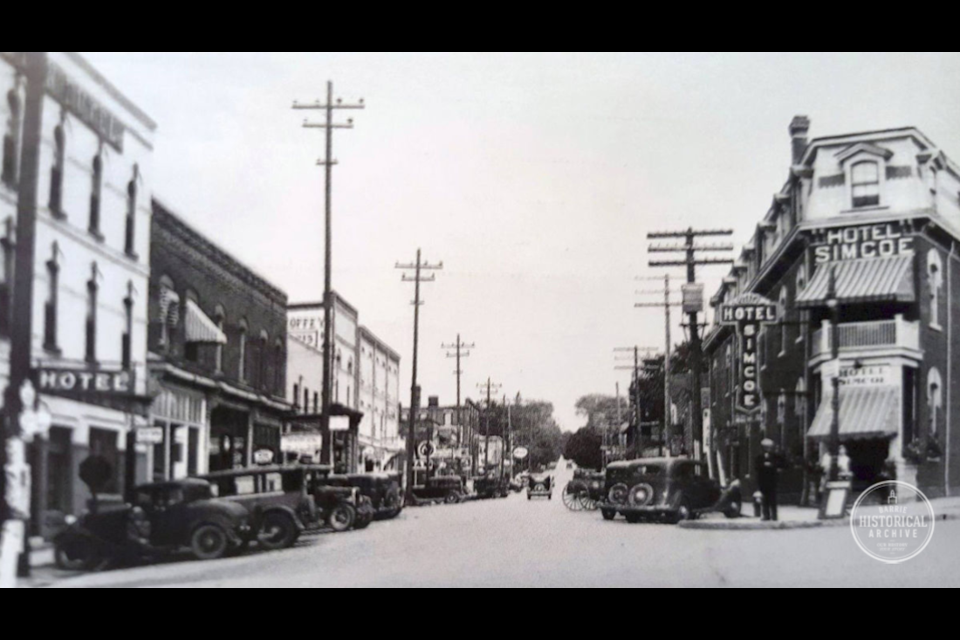“Thieving Epidemic Sweeps District!” So proclaimed the bold-lettered headline of the Barrie Advance on Nov. 15, 1938. Indeed, in these difficult economic times towards the end of the Depression years, the stealing of goods was becoming all too common.
In that edition, Barrie Police Chief Alex Stewart held nothing back when he laid blame.
“The situation is province-wide and the parties responsible are hoboes, young men out of work, children, and the home owners and businessmen who fail to take precautions to see that their premises are securely locked.’’
Perhaps the good people of Barrie had been unaccustomed to this sort of thing, and trusting that they knew all their neighbours, had never before felt a need to lock anything up. It may be that desperate people from other places knew that Barrie was easy pickings, because the culprits, once apprehended, usually turned out to be from another locality.
This was true of the shocking jewel heist that occurred at 76 Dunlop St. E. on Oct. 14, 1938. The International Plowing match had arrived in Minesing, 14 miles west of Barrie, and brought with it 132,000 attendees, a record number. Among them were five young men who arrived from Toronto and left with more than just a cheap souvenir.
They must have been quick as they entered Reeve’s Jewellers through a fanlight, just above the front door, in between regular police checks. A member of the quintet later confessed that they were already inside when beat officers tried the door to ensure it was locked. In a flash, the robbers dumped upwards of $3,000 worth of watches, rings and Ronson cigarette lighters into a cardboard box and made off.
Jack Dyck had parked the truck he used for his meat business outside 48 Bayfield St., and it was from there that it disappeared. Only when Gordon Reeves opened up his shop at 8 a.m. that Friday morning did anything seem amiss. Local police thought that the two crimes might be connected and wisely reported both to agencies in other districts.
That same morning, the stolen truck was found on Wood Street in Toronto, very near Maple Leaf Gardens. That discovery was very quickly connected to some young fellows who lived at, or were associated with, a house on Beaty Avenue, near the old Sunnyside Station.
Chief Stewart traveled down to the city to investigate the crime along with the Toronto Police. He was there when the case broke wide open on Saturday. Acting on a tip, detectives kept watch on 26 Beaty Ave. until they spotted 18-year-old Alexander Young coming out of the residence. They made their move and arrested the lad.
Young was not long in spilling all the details, and quickly implicated Merk ‘Mike’ Kornick, Walter Andrew, William Burton and George Giffen. He told the police all about the cardboard box of loot and how he and Kornick had transported it to Toronto, ditched the truck, and stashed their haul first in Kornick’s rented room on Gloucester Street just north of Wood Street.
The goods were next kept in a locker at Sunnyside Station before being brought to 26 Beaty Ave. Some of the stolen items were found in a zippered leather bag, some on the persons arrested, and the last of it buried under a loose concrete block, two feet below the cellar floor.
Young and Kornick ended up pleading guilty to break and entering, while Andrew offered a guilty plea to the charge of receiving stolen goods. The truck theft charges against the three were withdrawn. No charges were brought against Burton and Giffen.
The three guilty parties each got a one-year definite sentence, with another year indefinite upon that, at hard labour in the Ontario Reformatory in Guelph, and were ordered to make restitution in regards to the pieces of jewellery that were never found.
Up until Christmas of 1938, Reeve’s held a special sale. Watches recovered from the robbery were slightly scuffed and offered for sale at 25 per cent off the regular price. Their newspaper advertisements complimented the police and noted that, because of their diligence, the items were only out of stock for two days.
Each week, the Barrie Historical Archive provides BarrieToday readers with a glimpse of the city’s past. This unique column features photos and stories from years gone by and is sure to appeal to the historian in each of us.



